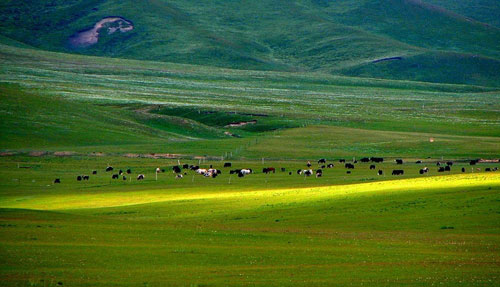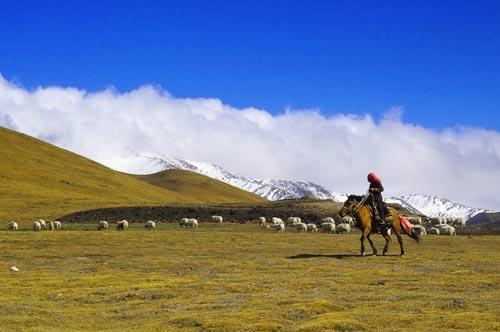The average elevation of Qilian Mountain is between 4,000-5,000 meters. The large, wide glacial landforms made by the Alpine snow are magnificent and spectacular. The altitude at 4,000 meters is called the "snow line" for obvious reasons. Generally speaking, it is a world of ice and snow where all else disappears. Natural miracles abound in this winter wonderland. For instance, there is canzhui, mushrooms formed in the layer of shallow snow; and the precious medicinal material, Snow Lotus, only found high in the mountains; and xueshancao which only grows under wind-carved rocks. Snow Lotus, canzhui and xueshancao are called the “Three Symbols of Winter”.

Damaying Grassland lies in the basin of Yanzhi Mountain and Qilian Mountain. Between July and August of every year, Qilian Mountain connects with the grassland in strips of green and white. Spacious green waves are covered with snow and interspersed horses, cattle and sheep all flock in the snow. When the gentle breeze blows, people get the sense they are recovering from a deep dream-filled slumber. Shandanjun Race Track, the Far East's number one track, with flat terrain, plenty of water and lush grass is built here.
The history of Qilian Grassland is cruel, but the nature of Qilian is absolutely warm and romantic. The name of Qilian Mountain comes from the ancient Hun Language and means “sky mountain”. The Yaoaoer, the direct descendants of nomadic Hun people, still call Qilian Mountain ”Tenggelidaban” which also means “sky mountain”.

At the foot of Qilian Mountain, there are grasslands, with the plumpest waves of grasses around, known as the Summer Tara (it is also called Huangchen Beach, Imperial City Beach and Grant Grass Flat). These used to be the pastures of Attila, the pasture of the Uyghurs and the pasture of the King of the Mongols, Kuoduan Khan, in the Yuan Dynasty. Summer Tara is a grassland with four distinct seasons plus a season for crops. The geographical masterpiece Qinibianjinve, Summary of the Border of Qin written by Laing Fenin the Qing Dynasty mentions the grassland: “the luxuriant grass only exists in the interior areas, not in the area north of the Great Wall.” The writer considered this area interior, for at that time the Nomaden and the farmers were fighting for control of the area. The Tibetan epic Geser described it as “Golden Lotus Grassland”. The Yaoaoer and the Mongols both call it “Summer Tara”, which means “golden pasture”.
To the east of Summer Tara Grassland is Damaying Beach which wraps around Yanzhi Mountain. The climate of Yanzhi Mountain is warm and heavily wooded, the hummock overgrows with silvery white Harigana Flowers and the Chuandi Grassland at the foot of Yanzhi Mountain stretches as far as our eyes can see. It is a lovely sight to see the Yaoaoer shepherds, carrying their white and black tents and driving their herds to wander amongst the golden sea of flowers all summer long.
The virgin forests of Qilian Mountain are even more charming. After the beginning of summer, Qilian Mountain is like a boundless green sea. There are 157,000 hectares and 2,000,000 cubic meters of forest within. It is one of greater forest areas in the Qinghai Province and various trees grow here such as spruce, sabina, and poplar. There are shrubs too: Bianma, Lycium ruthenicum and Pentaclethra macrophylla. In addition to the thick forests and snow-capped peaks of Qilian Mountain, one can enjoy the many roaming deer frolicking about.
There is no "best time to visit" Qilianshan since their isn’t a very clear distinction between the four seasons. Spring does not look like spring, and summer does not look like the summer. It is the so-called "snow in June of the Qilian Mountain”, which truly reflects the majesty and allure of this magical place. July through August is traditionally the best time to visit though, since during this period there are many local activities and festivals.
Getting Around
-- It takes a whole day to reach Qilian from Xining by bus and the current price is 36 RMB. (The coach station is located at the north end of Jianguo Road which is about 600 meters from the southern railway station).
-- The cost of a chartered taxi is 2RMB per kilometer. If you wish to hire a taxi, you should charter a vehicle from Xining, because it is difficult to charter one after arriving in Qilian.Accommodation
-- The hotels in Qilian Mountain are very expensive.
-- In Qinghai Lake, there are numerous hotels with full range of facilities, as well as hotels of all styles.
-- In other major cities and towns in the north and south of Qinghai, hotels of all star classes can be found.Local Food
Mushrooms in Qilian are very famous and cooks in the many restaurants make use of this special local product. Tibetan, Mongolian and Hui people are all experts in the art of boiling tea with milk; this kind of tea is sweet, nutritious and delicious. Tibetan food here is all very unique. The most famous local treat is a pastry of sorts called “biscuit snack”" or “tuzi". It is sweet and savory – the perfect compliment to your warm tea.
Read the original in Chinese here
***
Related Links
Hulun Buir Grassland - Inner Mongolia
A Cold Rain in Qining
Swan Lake of the Plateau
Beautiful Qinghai in China's North West-In Pictures
Warning:The use of any news and articles published on eChinacities.com without written permission from eChinacities.com constitutes copyright infringement, and legal action can be taken.
All comments are subject to moderation by eChinacities.com staff. Because we wish to encourage healthy and productive dialogue we ask that all comments remain polite, free of profanity or name calling, and relevant to the original post and subsequent discussion. Comments will not be deleted because of the viewpoints they express, only if the mode of expression itself is inappropriate.
Please login to add a comment. Click here to login immediately.